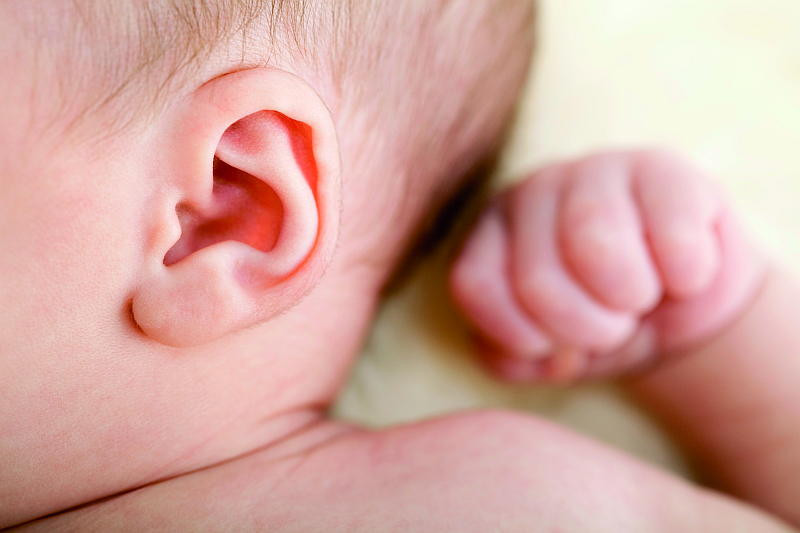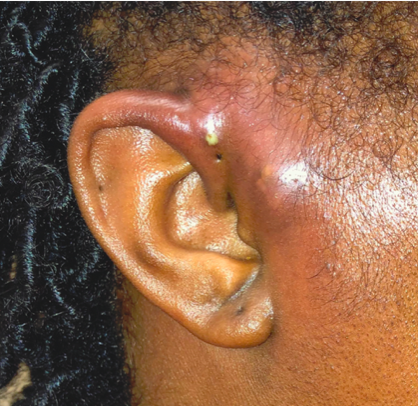Definisi
Mastoiditis adalah infeksi yang menyerang tulang temporal, terutama pada bagian sel udara mastoid. Tulang temporal adalah sebuah tulang di kepala, yang terletak tepat di belakang telinga. Sementara itu, sel udara mastoid adalah bagian tulang temporal yang berongga dan bersekat-sekat, seperti sarang lebah. Sel udara mastoid terhubung dengan telinga bagian tengah.
Penyebab
Mastoiditis pada umumnya merupakan komplikasi dari infeksi pada telinga tengah (otitis media). Namun, untuk dapat menyebabkan mastoiditis, otitis media perlu terjadi secara berulang. Pada kasus lainnya, sebuah kondisi bernama kolesteatoma dapat menyebabkan mastoiditis. Kolesteatoma merupakan penumpukan sel-sel kulit di dalam liang telinga yang dapat menghambat pembersihan alami telinga, sehingga mempermudah terjadinya infeksi. Infeksi ini dapat menyebar ke mastoid dan menghancurkan sekat-sekat pada sel udara. Akibatnya, sel udara menjadi lebih besar dan dipenuhi oleh nanah.
Bakteri penyebab mastoiditis yang paling sering adalah Streptococcus pneumoniae. Selain itu, bakteri penyebab lainnya berupa Streptococcus beta-hemolitikus grup A, Staphylococcus aureus, Streptococcus pyogenes, dan Haemophilus influenzae.
Faktor Risiko
Mastoiditis lebih sering menyerang anak-anak daripada orang dewasa, terutama anak-anak berusia di bawah 2 tahun. Faktor risiko mastoiditis lainnya adalah:
- Sistem kekebalan tubuh yang kurang baik
- Infeksi telinga tengah berulang
- Pembentukan sel udara mastoid yang tidak sempurna
Gejala
Biasanya, anak dengan mastoiditis akan datang dengan keluhan rewel, mudah marah, cenderung mengantuk, demam, menarik-narik telinga, dan nyeri telinga. Sementara itu, orang dewasa biasanya akan datang dengan keluhan nyeri telinga hebat, demam, serta nyeri kepala. Gejala lainnya dapat berupa:
- Bagian belakang telinga terlihat kemerahan, terasa hangat dan nyeri
- Pembengkakan di belakang telinga yang dapat menyebabkan telinga terlihat lebih menonjol
- Keluar cairan dari telinga
- Demam, mudah marah, dan lelah (pada anak)
- Penurunan pendengaran pada telinga yang bersangkutan
Gejala-gejala ini pada umumnya muncul setelah infeksi telinga berulang atau infeksi telinga yang sangat berat.
Diagnosis
Pemeriksaan telinga
Untuk mendiagnosis mastoiditis, dokter dapat menggunakan alat yang disebut sebagai otoskop. Alat ini memiliki lampu dan kaca pembesar sehingga dokter dapat melihat bagian dalam liang telinga. Selain itu, dokter juga akan memeriksa bagian belakang telinga untuk mencari adanya pembengkakan.
Pemeriksaan penunjang
Pemeriksaan laboratorium dan pencitraan pada umumnya dilakukan ketika dokter ingin mencari tahu komplikasi dari mastoiditis.
Pemeriksaan laboratorium yang dilakukan dapat berupa:
- Darah lengkap dengan hitung jenis sel darah putih
- Laju endap darah
- C-reactive protein (CRP)
Berdasarkan hasil pemeriksaan, apabila ditemukan kantong berisi nanah (di leher, telinga, mastoid, atau tulang belakang), nanah akan dialirkan keluar dan dikirim ke laboratorium untuk dilakukan kultur bakteri. Kultur bakteri merupakan pengembangbiakan bakteri yang bertujuan untuk mengetahui jenis bakteri yang menyebabkan infeksi serta keampuhan antibiotik untuk melawan bakteri tersebut.
Sementara itu, pencitraan dapat dilakukan dengan foto rontgen atau computed tomography scan (CT scan), tergantung ketersediaan fasilitas. Anda atau anak Anda dapat dirujuk untuk pemeriksaan CT scan, karena tidak semua fasilitas kesehatan memiliki pemeriksaan ini. CT scan dilakukan dengan menyinari anggota tubuh yang bersangkutan dengan sinar X dan dibantu oleh komputer untuk menghasilkan gambaran yang mendetail.
Tata Laksana
Terapi antibiotik
Terapi utama mastoiditis adalah pemberian antibiotik. Orang yang mengalami mastoiditis dapat dirawat inap apabila antibiotik diberikan lewat infus. Selain antibiotik, obat lainnya dapat berupa steroid yang diberikan lewat infus. Jika Anda berkunjung ke dokter umum, dokter akan merujuk Anda ke spesialis telinga, hidung, dan tenggorokan untuk pemeriksaan dan tata laksana lanjutan.
Prosedur pembedahan
Pilihan terapi lainnya dapat dipilih sesuai keparahan infeksi. Tata laksana tersebut dapat berupa miringotomi, pemasangan selang timpanostomi, dan mastoidektomi. Miringotomi adalah pemotongan gendang telinga untuk menyediakan jalan keluar bagi nanah, dan hanya dapat dilakukan apabila gendang telinga utuh. Pada mastoiditis, gendang telinga dapat berlubang ataupun utuh. Pemasangan selang timpanostomi merupakan pemasangan selang yang masuk lewat gendang telinga menuju telinga tengah, yang juga bertujuan untuk mengalirkan nanah keluar. Sementara itu, mastoidektomi adalah sebuah prosedur untuk mengangkat sel-sel udara mastoid yang sudah terinfeksi oleh bakteri.
Pada kasus mastoiditis tanpa komplikasi, pemberian antibiotik, steroid, dan miringotomi dengan pemasangan selang timpanostomi sudah cukup. Selama perawatan, pemantauan akan dilakukan secara rutin karena kondisi pasien dapat menurun dengat cepat. Jika mastoiditis tidak menunjukkan perbaikan dalam 2 hari, dokter dapat memilih untuk melakukan mastoidektomi.
Setelah operasi, Anda atau anak Anda membutuhkan istirahat selama 7-10 hari. Ada beberapa hal yang perlu diperhatikan, yaitu:
- Menjaga agar telinga yang dioperasi tetap kering, agar luka bekas operasi dapat sembuh dengan baik
- Jangan keramas hingga dokter menyatakan Anda atau anak Anda dapat keramas. Biasanya, Anda atau anak Anda akan diperbolehkan keramas setelah 1 minggu, dengan tetap berhati-hati agar air tidak masuk ke dalam telinga
- Menunda berenang hingga 4-6 minggu setelah operasi. Hal ini bertujuan untuk mencegah air masuk ke dalam telinga dalam jumlah banyak. Oleh karena itu, hal ini sangat tergantung dari proses penyembuhan pada telinga
Komplikasi
Komplikasi mastoiditis dapat menjadi fatal, karena penyebaran infeksi dapat terjadi ke berbagai tempat. Penyebaran infeksi ini dibagi menjadi dua kelompok besar, yaitu ekstrakranial (di luar rongga kepala yang berisi otak) dan intrakranial (di dalam rongga kepala yang berisi otak).
Komplikasi di luar rongga kepala dapat berupa:
- Abses (kantong berisi nanah) pada bagian luar tengkorak, di dekat mastoid
- Kelumpuhan saraf wajah akibat penekanan saraf
- Labirintitis yang disebabkan oleh penyebaran infeksi ke telinga bagian dalam, ditandai dengan pusing berputar dan penurunan pendengaran sebagai akibat dari peradangan pada saraf
- Apisitis petrosa, yaitu penyebaran infeksi ke bagian tulang tengkorak lainnya. Penyakit ini ditandai dengan keluarnya cairan dari telinga, nyeri di belakang mata, kelumpuhan otot mata pada satu sisi, dan beberapa kelainan saraf lainnya
- Abses Bezold, yaitu abses yang terjadi pada selaput yang menyelimuti otot pada leher
Sementara itu, komplikasi yang dapat terjadi di dalam rongga kepala berupa:
- Abses pada otak bagian temporal (samping), serebelum (otak kecil), atau lapisan pelindung kepala
- Meningitis (infeksi pada selaput otak)
- Trombosis sinus venosus, atau macetnya aliran darah pada pembuluh darah balik di otak
Pada komplikasi jenis ini, gejala yang dapat muncul berupa kejang, nyeri kepala, dan penurunan kesadaran.
Pencegahan
Pencegahan mastoiditis dapat dilakukan dengan pengobatan infeksi telinga. Jika Anda atau anak Anda mengalami infeksi telinga berulang, sebaiknya infeksi tersebut diobati agar tidak berlanjut menjadi mastoiditis. Biasanya, terapi infeksi telinga dapat dilakukan dengan mengonsumsi antibiotik selama 7-10 hari sesuai dengan anjuran dokter.
Kapan Harus ke Dokter?
Segera ke dokter apabila Anda atau anak Anda mengalami:
- Gejala mastoidits
- Infeksi telinga yang tidak membaik dengan obat-obatan atau diikuti dengan gejala-gejala baru
- Telah terdiagnosis mastoiditis dan terapi tidak membantu pemulihan
Apabila tidak ditangani secara tuntas, mastoiditis dapat berakibat fatal hingga mengancam nyawa. Oleh karena itu, infeksi telinga, baik pada telinga luar, tengah, dalam, maupun mastoiditis harus segera ditangani.
- dr Hanifa Rahma
- dr. Monica Salim
Burke, D., & Biggers, A. (2017). Mastoiditis: Causes, Symptoms, and Diagnosis. Retrieved 10 March 2022, from https://www.healthline.com/health/mastoiditis
Marks, H., & Khatri, M. (2021). Ear Infections and Mastoiditis. Retrieved 10 March 2022, from https://www.webmd.com/cold-and-flu/ear-infection/mastoiditis-symptoms-causes-treatments
Mastoiditis. (2019). Retrieved 10 March 2022, from https://www.nhs.uk/conditions/mastoiditis/
Sahi, D., Nguyen, H., & Callender, K. (2021). Mastoiditis. Retrieved 10 March 2022, from https://www.ncbi.nlm.nih.gov/books/NBK560877/











